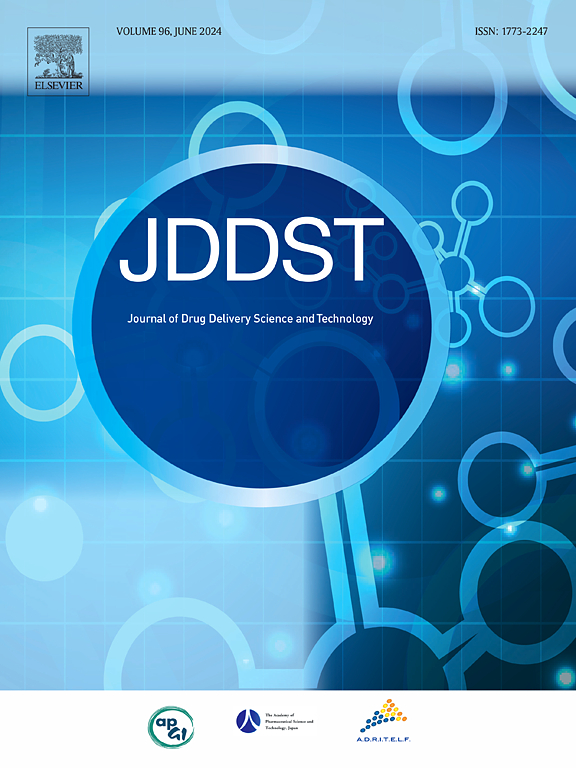Multi-scale study on the volatility of essential oil and its modulation methods
IF 4.5
3区 医学
Q1 PHARMACOLOGY & PHARMACY
Journal of Drug Delivery Science and Technology
Pub Date : 2025-06-29
DOI:10.1016/j.jddst.2025.107227
引用次数: 0
Abstract
Essential oil (EO), a mixture of volatile components with diverse pharmacological effects, faces challenges due to volatility impacting therapeutic efficacy. To address this, we developed an integrated multiscale methodology combining simultaneous thermal analysis, gas chromatography, and molecular dynamics simulations. This approach quantitatively explores EO component volatility and elucidates the mechanisms by which fixatives (nerolidol, farnesol, ethyl cinnamate) and 13X-HP zeolite encapsulation modulate volatilization. Our findings demonstrate that volatility is primarily governed by molecular structural class, molecular weight, and functional groups. Based on volatility parameters (e.g., Tmax ranging from 124.1 °C to 260.0 °C, volatilization in 12 h ranging from 33.12 % to 100 %, etc.), EO components were categorized into top (>95 % volatilization in 2 h), middle, and base (<50 % volatilization after 12 h) notes, providing a choice basis for duration-specific aromatherapy. Notably, low-volatility EOs showed potential as fixatives. Mechanistic insights revealed that the ethyl cinnamate prolongs the volatilization of representative EO components by 10.76 %–24.02 % through polarity-modulated intermolecular interactions modulated by polarity, irrespective of its own volatility. For zeolite encapsulation, 13X-HP exhibited pore-size (∼10 Å) dependent effects: effectively delaying the release of smaller monoterpenes (e.g., ocimene volatilization decreased 3.95 %) but unexpectedly accelerating the release of larger components (e.g., citral volatilization increased 12.59 %). The modulated release was governed by adsorption location, component characteristics, and adsorption energy (<−31470.4 kJ/mol correlating with longer release). Critically, the strong concordance between macroscopic experiment data and microscopic simulations validates this integrated methodology as a powerful tool for the rational selection of EO components and the design of controlled-release systems.

精油挥发性及其调节方法的多尺度研究
精油是一种具有多种药理作用的挥发性成分的混合物,由于挥发性影响治疗效果而面临挑战。为了解决这个问题,我们开发了一种集成的多尺度方法,结合了同步热分析、气相色谱和分子动力学模拟。该方法定量探索了EO组分的挥发性,并阐明了固定剂(神经醇、法尼醇、肉桂酸乙酯)和13X-HP沸石包封调节挥发的机制。我们的研究结果表明,挥发性主要受分子结构类别、分子量和官能团的控制。根据挥发性参数(如Tmax在124.1°C至260.0°C之间,12 h内挥发度在33.12%至100%之间等),将EO组分分为顶级(2 h内挥发度为95%)、中级和基础(12 h后挥发度为50%),为持续芳香疗法的选择提供依据。值得注意的是,低波动性的EOs显示出作为固定资产的潜力。机理分析表明,肉桂酸乙酯通过极性调制的分子间相互作用,使典型EO组分的挥发延长10.76% - 24.02%,而不考虑其自身的挥发性。对于沸石包封,13X-HP表现出孔径(~ 10 Å)依赖效应:有效延缓较小的单萜烯的释放(例如,辛烯挥发减少3.95%),但意想不到地加速较大成分的释放(例如,柠檬醛挥发增加12.59%)。调节释放受吸附位置、组分特性和吸附能(<−31470.4 kJ/mol,与较长的释放相关)控制。重要的是,宏观实验数据和微观模拟之间的强烈一致性验证了这种集成方法是合理选择EO组件和设计控释系统的有力工具。
本文章由计算机程序翻译,如有差异,请以英文原文为准。
求助全文
约1分钟内获得全文
求助全文
来源期刊
CiteScore
8.00
自引率
8.00%
发文量
879
审稿时长
94 days
期刊介绍:
The Journal of Drug Delivery Science and Technology is an international journal devoted to drug delivery and pharmaceutical technology. The journal covers all innovative aspects of all pharmaceutical dosage forms and the most advanced research on controlled release, bioavailability and drug absorption, nanomedicines, gene delivery, tissue engineering, etc. Hot topics, related to manufacturing processes and quality control, are also welcomed.

 求助内容:
求助内容: 应助结果提醒方式:
应助结果提醒方式:


